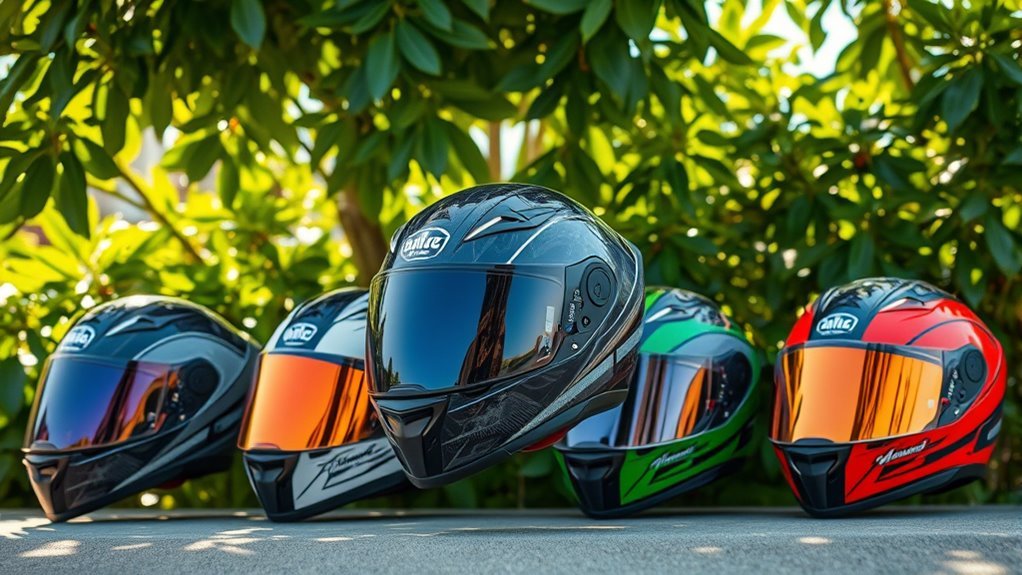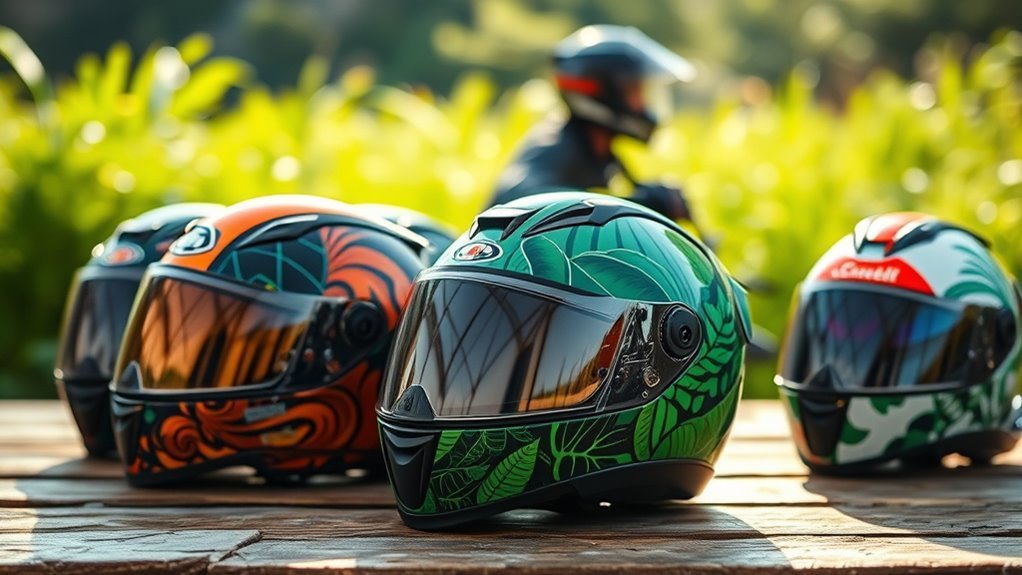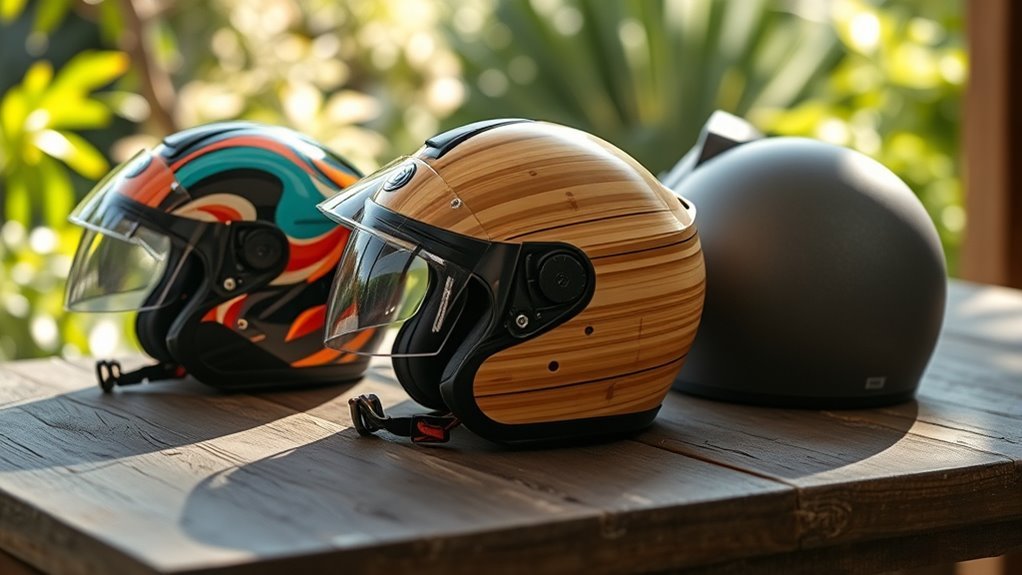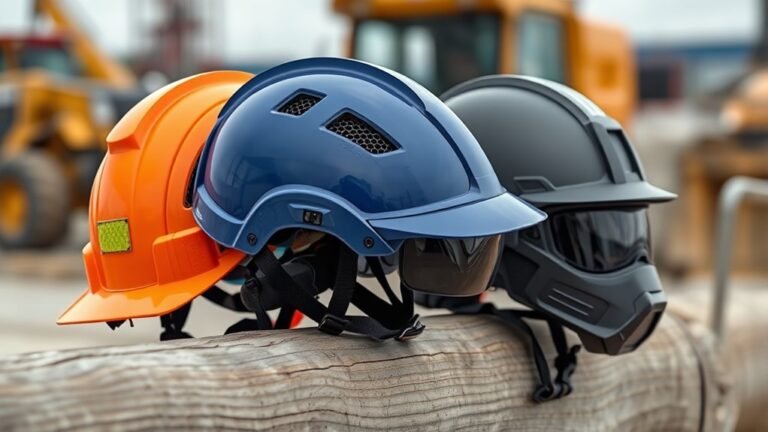Top Sustainable Motorcycle Helmet Brands in 2025
In 2025, some of the top sustainable motorcycle helmet brands focus on eco-friendly materials and innovative production processes. They’re utilizing biodegradable composites to reduce waste and opting for local sourcing to support communities. Plus, these brands prioritize safety certifications, ensuring you can ride with confidence. As more companies initiate helmet recycling programs and explore upcycling opportunities, it’s clear the future of motorcycle gear is greener. Learn about the brands leading this charge and their unique offerings.
Eco-Friendly Materials in Helmet Design

As the demand for sustainable products grows, helmet manufacturers are increasingly turning to eco-friendly materials in their designs. You’ll find that many brands are now using biodegradable composites, which break down naturally, minimizing their environmental impact. These materials not only help reduce waste but also align with the sustainable aesthetics that appeal to eco-conscious riders like yourself. Imagine wearing a helmet that embodies freedom, not just in your ride but also in its environmental footprint. By choosing helmets crafted from eco-friendly materials, you’re supporting a movement towards responsible manufacturing. This shift signifies a commitment to preserving the planet while enjoying the thrill of the open road. Embrace this change; it’s about riding with purpose and protecting what you love.
Innovative Production Processes

While many helmet brands embrace eco-friendly materials, their commitment to sustainability doesn’t stop there; innovative production processes are also playing a crucial role in reducing environmental impact. By focusing on sustainable sourcing, brands are minimizing waste and energy consumption. Techniques like 3D printing not only streamline manufacturing but also support a circular economy, allowing for easy recycling and repurposing of materials.
Here’s a quick comparison of innovative processes:
| Production Process | Benefits | Sustainability Impact |
|---|---|---|
| 3D Printing | Reduces material waste | Supports circular economy |
| Modular Design | Easier repair/replacement | Increases product lifespan |
| Biodegradable Resin | Eco-friendly materials | Decreases landfill waste |
These advancements pave the way for a more sustainable future in the motorcycle helmet industry.
Brands Leading the Sustainable Charge

As you explore the landscape of sustainable motorcycle helmets, you’ll notice brands stepping up with eco-friendly material innovations and ethical manufacturing practices. These companies not only prioritize safety but also commit to reducing their environmental impact. Let’s take a closer look at how these leaders are reshaping the industry for a greener future.
Eco-Friendly Material Innovations
Innovation drives the motorcycle helmet industry toward sustainability, with several brands leading the way in eco-friendly material advancements. You’ll find helmets made from biodegradable composites that break down naturally, reducing environmental impact without compromising safety. These materials not only protect you but also help the planet thrive. Additionally, brands are embracing sustainable textiles, offering straps and liners made from recycled materials, providing comfort while maintaining a low carbon footprint. As you ride into the future, knowing your gear supports eco-friendliness adds to the thrill of freedom on the open road. Choosing these innovative helmets means you’re not just a rider; you’re a part of a movement toward a more sustainable lifestyle. Embrace the change and ride responsibly!
Ethical Manufacturing Practices
When you choose a motorcycle helmet, the brand’s commitment to ethical manufacturing practices can greatly impact both your safety and the environment. Brands that prioritize transparency in their supply chain and uphold labor rights often lead the charge in sustainability. Here’s what you should look for:
- Supply Chain Transparency: Brands that openly share their sourcing methods promote accountability.
- Fair Labor Rights: Supporting manufacturers who guarantee fair wages and safe working conditions empowers workers globally.
- Sustainable Production Methods: Eco-friendly processes reduce waste and lower the environmental footprint.
Certification and Safety Standards
While choosing a sustainable motorcycle helmet, understanding certification and safety standards is essential for ensuring your safety on the road. Helmet certifications, like DOT, ECE, and Snell, indicate that the helmet meets specific safety regulations. These standards assess impact resistance, penetration, and retention, providing peace of mind that you’re protected in the event of an accident. When you’re cruising down the open road, you want to know your gear has passed rigorous testing. Look for helmets that proudly display these certifications, as they reflect a commitment to your safety and the environment. By selecting a certified sustainable helmet, you’re not just protecting yourself; you’re also supporting brands that prioritize both safety and eco-friendliness. Ride free and safe!
Recycling and End-of-Life Options
Once you’ve verified your helmet meets the necessary safety certifications, it’s time to think about what happens when it reaches the end of its life cycle. You’ve got options for recycling and helmet disposal that contribute to a sustainable future.
- Join recycling programs: Many brands offer take-back initiatives to guarantee responsible recycling.
- Explore local recycling facilities: Some communities have specialized programs for motorcycle gear.
- Consider donation: If the helmet’s still usable, donating it can extend its life and help others.
Consumer Impact and Choices
As consumers increasingly prioritize sustainability, your choices in helmet purchasing can greatly influence the motorcycle industry’s environmental impact. By aligning your consumer preferences with brands that emphasize eco-friendly materials and production processes, you’re not just making a purchase; you’re casting a vote for a greener future. Every helmet you buy contributes to a larger narrative of sustainability, shaping how manufacturers operate. When you consider factors like recyclability, ethical sourcing, and carbon footprint in your purchasing decisions, you inspire change within the industry. Embracing sustainable options not only enhances your riding experience but also promotes responsible practices. Ultimately, your choices matter, and they can steer the motorcycle market towards a more sustainable, freedom-driven path.
The Future of Sustainable Motorcycle Helmets
As you look towards the future of sustainable motorcycle helmets, you’ll notice exciting innovations in eco-friendly materials and production processes that prioritize both safety and the environment. Companies are racing to develop recycling and end-of-life solutions, ensuring that your helmet contributes to a circular economy rather than ending up in a landfill. This shift not only benefits the planet but also enhances your riding experience with cutting-edge technology and design.
Eco-friendly Materials Innovation
In 2025, the motorcycle helmet industry is set to undergo a transformative shift, driven by innovations in eco-friendly materials. You’ll soon see helmets crafted from biodegradable composites and natural fibers, paving the way for a greener ride. This evolution not only enhances safety but also aligns with your values for a sustainable lifestyle. Here are some exciting developments to look forward to:
- Biodegradable Composites: Helmets that break down naturally, reducing landfill waste.
- Natural Fibers: Materials like hemp and bamboo offering strength without harming the planet.
- Recycled Materials: Incorporating waste products to create durable, lightweight helmets.
These innovations promise to redefine your riding experience, merging safety with environmental consciousness. Get ready to ride sustainably!
Production Process Improvements
While the shift towards eco-friendly materials is exciting, the production processes behind sustainable motorcycle helmets are equally essential for the industry’s future. You’ll want to know that brands are now prioritizing sustainable sourcing, ensuring that every component comes from environmentally responsible suppliers. This approach not only reduces waste but also supports local economies, enhancing community ties. Additionally, innovations in production efficiency are transforming manufacturing methodologies, cutting down energy consumption and minimizing carbon footprints. Techniques like 3D printing and automated assembly lines are helping brands produce helmets faster and with fewer resources. By embracing these improvements, the industry is paving the way for a more sustainable future, offering you freedom on the road while respecting the planet.
Recycling and End-of-life Solutions
Although many riders enjoy the thrill of the open road, it’s crucial to contemplate what happens to motorcycle helmets once they’re no longer safe to use. Embracing responsible recycling and end-of-life options guarantees you contribute to a sustainable future. Here’s how you can make a difference:
- Participate in recycling programs that accept old helmets, minimizing landfill waste.
- Explore upcycling opportunities, turning your helmet into unique art or functional items.
- Support brands that offer take-back initiatives, ensuring proper disposal and material recovery.
Frequently Asked Questions
How Do Sustainable Helmets Compare in Price to Traditional Helmets?
Sustainable helmets can often cost more than traditional ones, but the price difference reflects their eco-friendly materials and production methods. In your cost analysis, you’ll notice market trends shifting as consumers increasingly value sustainability. While traditional helmets might seem cheaper upfront, investing in a sustainable option can benefit both your wallet and the planet in the long run. Ultimately, it’s about balancing personal freedom with environmental responsibility.
Are There Specific Care Instructions for Sustainable Motorcycle Helmets?
Yes, there are specific care instructions for sustainable motorcycle helmets. To keep your helmet in top shape, focus on the care materials used. Use a damp cloth with mild soap for cleaning, avoiding harsh chemicals that can damage the eco-friendly materials. Store it in a cool, dry place, and regularly check for any wear. Following these maintenance tips guarantees your helmet remains safe and lasts longer, giving you the freedom to ride worry-free.
Can Sustainable Helmets Be Customized for Personal Styles?
Yes, sustainable helmets can absolutely be customized for your personal style! Imagine cruising on your bike, sporting a helmet that not only reflects your unique taste but is also made from eco-friendly materials. Many brands offer custom designs, allowing you to choose colors, graphics, and even textures that resonate with you. It’s a perfect blend of safety and self-expression, letting you ride with freedom while staying true to your values.
What Is the Lifespan of a Sustainable Motorcycle Helmet?
A sustainable motorcycle helmet typically lasts around 5 to 7 years, depending on various longevity factors like usage, maintenance, and exposure to elements. The environmental impact of these helmets is vital; opting for materials that degrade less can enhance their lifespan. Remember, even if a helmet looks fine, internal degradation can occur. Regular checks and timely replacements guarantee your safety while minimizing waste, giving you the freedom to ride responsibly and sustainably.
Are Sustainable Helmets Available in Different Sizes and Shapes?
Yes, sustainable helmets come in a variety of sizes and shapes, just like a well-stocked toolbox ready for any job. You’ll find sizing options that cater to different head measurements, ensuring a snug fit. Additionally, helmet shapes vary—from classic designs to more aerodynamic profiles—so you can choose what suits your riding style. With these choices, you can enjoy the freedom of the open road while prioritizing safety and sustainability.






